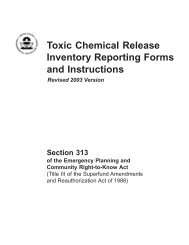(Lockout/Tagout) (revised 2002) OSHA 3120 - Seton
(Lockout/Tagout) (revised 2002) OSHA 3120 - Seton
(Lockout/Tagout) (revised 2002) OSHA 3120 - Seton
You also want an ePaper? Increase the reach of your titles
YUMPU automatically turns print PDFs into web optimized ePapers that Google loves.
Background<br />
How should I use this booklet?<br />
This booklet presents <strong>OSHA</strong>’s general requirements for<br />
controlling hazardous energy during service or maintenance<br />
of machines or equipment. It is not intended to replace or to<br />
supplement <strong>OSHA</strong> standards regarding the control of hazardous<br />
energy. After reading this booklet, employers and other<br />
interested parties are urged to review the <strong>OSHA</strong> standards<br />
on the control of hazardous energy to gain a complete<br />
understanding of the requirements regarding the control of<br />
hazardous energy. These standards, as well as other relevant<br />
resources, are identified throughout this publication.<br />
What is “lockout/tagout”?<br />
“<strong>Lockout</strong>/tagout” refers to specific practices and procedures<br />
to safeguard employees from the unexpected energization or<br />
startup of machinery and equipment, or the release of hazardous<br />
energy during service or maintenance activities. 1 This requires,<br />
in part, that a designated individual turns off and disconnects<br />
the machinery or equipment from its energy source(s) before<br />
performing service or maintenance and that the authorized<br />
employee(s) either lock or tag the energy-isolating device(s) to<br />
prevent the release of hazardous energy and take steps to verify<br />
that the energy has been isolated effectively. If the potential<br />
exists for the release of hazardous stored energy or for the<br />
reaccumulation of stored energy to a hazardous level, the<br />
employer must ensure that the employee(s) take steps to prevent<br />
injury that may result from the release of the stored energy.<br />
<strong>Lockout</strong> devices hold energy-isolation devices in a safe or<br />
“off” position. They provide protection by preventing machines<br />
or equipment from becoming energized because they are<br />
1 The standard refers to servicing and maintaining “machines or<br />
equipment.” Although the terms “machine” and “equipment” have<br />
distinct meanings, this booklet uses the term “machines” to refer both<br />
to machines and equipment. This is done for purposes of brevity only,<br />
and readers should not infer that it is intended to limit the scope of the<br />
standard. The term “equipment” is broad in scope and encompasses all<br />
types of equipment, including process equipment such as piping systems.<br />
How should I use this booklet?<br />
1
















